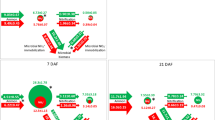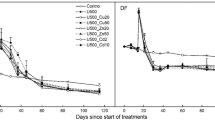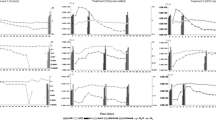Abstract
A greenhouse experiment was conducted with five Elymus grass species: Elymus dahuricus Turcz., Elymus cylindricus Franchet, Elymus breviaristatus Keng f., Elymus nutans Griseb., and Elymus sibiricus L., measuring N2O emissions from sheep urine-affected soil, and a biological nitrification inhibition (BNI) assay was performed on root exudates of these five species. The abundances of amoA gene of ammonia-oxidizing bacteria and archaea and nirK and nirS denitrification genes were measured by quantitative polymerase chain reaction. The mean total emissions over 6 weeks varied significantly among the Elymus species and ranged from 0.34 to 0.94 kg N2O-N·ha−1 in the urine treatment. The highest emissions were observed from Elymus breviaristatus while the lowest emissions were observed in Elymus sibiricus. All the Elymus grass species were capable of exuding BNI compounds and the highest BNI capacity was observed in Elymus sibiricus. The nirS gene abundance response to urine addition was significantly greater than other genes and varied significantly depending on Elymus species. The BNI % and nirS gene abundance were negatively and positively, respectively, related to total N2O-N emissions during the first 2 weeks after urine addition when emissions were apparent.




Similar content being viewed by others
References
Abalos D, De Deyn GB, Kuyper TW, Van G, Jan W (2014) Plant species identity surpasses species richness as a key driver of N2O emissions from grassland. Glob Chang Biol 20:265–275
Abalos D, Groenigen JW, De Deyn GB (2018) What plant functional traits can reduce nitrous oxide emissions from intensively managed grasslands? Glob Chang Biol 24:248–258
Bardon C, Piola F, Bellvert F, Haichar FZ, Comte G, Meiffren G, Pommier T, Puijalon S, Tsafack N, Poly F (2014) Evidence for biological denitrification inhibition (BDI) by plant secondary metabolites. New Phytol 204:620–630
Bardon C, Poly F, Piola F, Pancton M, Comte G, Meiffren G, Haichar FZ (2016) Mechanism of biological denitrification inhibition: procyanidins induce an allosteric transition of the membrane-bound nitrate reductase through membrane alteration. FEMS Microbiol Ecol 92:fiw034
Blunden J, Arndt DS (2013) State of the climate in 2012. Bull Am Meteorol Soc 94:S75–S78
Bowatte S, Hoogendoorn CJ, Newton PCD, Liu Y, Brock SC, Theobald PW (2018) Grassland plant species and cultivar effects on nitrous oxide emissions after urine application. Geoderma 323:74–82
Bowatte S, Newton PCD, Hoogendoorn CJ, Hume DE, Stewart AV, Brock SC, Theobald PW (2016) Wide variation in nitrification activity in soil associated with different forage plant cultivars and genotypes. Grass Forage Sci 71:160–171
Bowatte S, Tillman R, Carran A, Scotter GD (2008) In situ ion exchange resin membrane (IEM) technique to measure soil mineral nitrogen dynamics in grazed pastures. Biol Fertil Soils 44:805–813
Byrnes RC, Nùñez J, Arenas L, Rao I, Trujillo C, Alvarez C, Arango J, Rasche F, Chirinda N (2017) Biological nitrification inhibition by Brachiaria grasses mitigates soil nitrous oxide emissions from bovine urine patches. Soil Biol Biochem 107:156–163
Casciotti KL, Ward BB (2001) Dissimilatory nitrite reductase genes from autotrophic ammonia-oxidizing bacteria. Appl Environ Microbiol 67:2213–2221
Chen XP, Zhu YG, Xia Y, Shen JP, He JZ (2008) Ammonia-oxidizing archaea: important players in paddy rhizosphere soil? Environ Microbiol 10:1978–1987
Coskun D, Britto DT, Shi W, Kronzucker HJ (2017) Nitrogen transformations in modern agriculture and the role of biological nitrification inhibition. Nat Plants 3:17074
De Klein CAM, Barton L, Sherlock RR, Li Z, Littlejohn RP (2003) Estimating a nitrous oxide emission factor for animal urine from some New Zealand pastoral soils. Aust J Soil Res 41:381–399
Francis CA, Roberts KJ, Beman JM, Santoro AE, Oakley BB (2005) Ubiquity and diversity of ammonia-oxidizing archaea in water columns and sediments of the ocean. Proc Natl Acad Sci USA 102:14683–14688
Galland W, Piola F, Burlet A, Mathieu C, Nardy M, Poussineau S, Blazère L, Gervaix J, Puijalon S, Simon L, Haichar FZ (2019) Biological denitrification inhibition (BDI) in the field: a strategy to improve plant nutrition and growth. Soil Biol Biochem 136:107513
Giles M, Morley N, Baggs EM, Daniell TJ (2012) Soil nitrate reducing processes drivers, mechanisms for spatial variation, and significance for nitrous oxide production. Front Microbiol 3:407
Gong ZT, Chen ZC, Shi XZ, Zhang GL, Zhang JM, Zhao WJ, Luo GB, Gao YX, Zhao SG, Cao ZH, Lei WJ (1999) Chinese soil taxonomy (in Chinese). Science Press, Beijing, p 903
Hoogendoorn CJ, Betteridge K, Coastal DA, Ledgard SF (2010) Nitrogen concentration in the urine of cattle, sheep, and deer grazing a common ryegrass/cocksfoot/white clover pasture. New Zealand J Agric Res 53:235–243
Kuzyakov Y, Xu X (2013) Competition between roots and microorganisms for nitrogen: mechanisms and ecological relevance. New Phytol 198:656–669
Louise B, Daniel VM, Klaus BB (2013) Influence of crop rotation and liming on greenhouse gas emissions from a semi-arid soil. Agric Ecosyst Environ 167:23–32
Luo J, Lindsey SB, Ledgard SF (2008) Nitrous oxide emissions from animal urine application on a New Zealand pasture. Biol Fertil Soils 44:463–470
Luo J, Hoogendoorn C, van der Weerden T, Saggar S, De Klein C, Giltrap D, Rollo M, Rys G (2013) Nitrous oxide emissions from grazed hill land in New Zealand. Agric Ecosyst Environ 181:58–68
Luo L, Sun XZ, Pacheco D, Ledgard SF, Lindsey SB, Hoogendoorn CJ, Wise B, Watkins NL (2015) Nitrous oxide emission factors for urine and dung from sheep fed either fresh forage rape (Brassica napus L.) or fresh perennial ryegrass (Lolium perenne L.). Animal 9:534–543
Ma JG, Bowatte S, Wang YF, Newton PCD, Hou FJ (2020) Differences in soil ammonia oxidizing bacterial communities under unpalatable (Stellera chamaejasme L.) and palatable (Elymus nutans Griseb.) plants growing on the Qinghai Tibetan Plateau. Soil Biol Biochem 144:107779
Ma X, Chen S, Zhang X, Bai S, Zhang C (2012) Assessment of worldwide genetic diversity of Siberian wild rye (Elymus sibiricus L.) germplasm based on gliadin analysis. Molecules 17:4424–4434
Michotey V, Mejean V, Bonin P (2000) Comparison of methods for quantification of cytochrome cd(1)-denitrifying bacteria in environmental marine samples. Appl Environ Microbiol 66:1564–1571
Nardi P, Laanbroek H, Nicole GW, Renella G, Cardinale M, Pietramellara G, Weckwerth W, Trinchera A, Ghatak A, Nannipeieri P (2020) Biological nitrification inhibition in the rhizosphere:determining interactions and impact on microbially mediated processes and potential applications. FEMS Microbiol Rev 44:874–908
O’Sullivan CA, Duncan EG, Whisson K, Treble K, Ward PR, Roper MMJP (2017) A colourimetric microplate assay for simple, high throughput assessment of synthetic and biological nitrification inhibitors. Plant Soil 413:1–13
Oenema O, Velthof GL, Yamulki S, Jarvis SC (2010) Nitrous oxide emissions from grazed grassland. Soil Use Manage 13:288–295
Ruser R, Schulz R (2015) The effect of nitrification inhibitors on the nitrous oxide (N2O) release from agricultural soils—a review. J Plant Nutr Soil Sci 178:171–188
Sarr PS, Ando Y, Nakamura S, Deshpande S, Subbarao GV (2019) Sorgoleone release from sorghum roots shapes the composition of nitrifying populations, total bacteria, and archaea and determines the level of nitrification. Biol Fertil Soils 56:145–166
Selbie DR, Buckthought LE, Shepherd MA (2015) The challenge of the urine patch for managing nitrogen in grazed pasture systems. Adv Agron 129:229–292
Simon PL, Dieckow J, Zanatta JA, Ramalho B, Ribeiro RH, van der Weerden T, De Klein CAM (2020) Does Brachiaria humidicola and dicyandiamide reduce nitrous oxide and ammonia emissions from cattle urine patches in the subtropics? Sci Total Environ 720:137692
Subbarao GV, Nakahara K, Hurtado MP, Ono H, Ito O (2009) Evidence for biological nitrification inhibition in Brachiaria pastures. Proc Natl Acad Sci USA 106:17302–17307
Subbarao GV, Sahrawat KL, Nakahara K, Rao IM, Ishitani M, Hash CT, Kishii M, Bonnett DG, Berry WL, Lata JC (2013) A paradigm shift towards low-nitrifying production systems: the role of biological nitrification inhibition (BNI). Ann Bot 112:297–316
Sun L, Lu Y, Yu F, Kronzucker HJ, Shi W (2016) Biological nitrification inhibition by rice root exudates and its relationship with nitrogen-use efficiency. New Phytol 212:646–656
Thompson RL, Lassaletta L, Patra PK, Wilson C, Canadell JG (2019) Acceleration of global N2O emissions seen from two decades of atmospheric inversion. Nat Clim Chang 9:1–6
Vázquez E, Teutscherova N, Dannenmann M, Töchterle P, Butterbach-Bahl K, Pulleman M, Arango J (2020) Gross nitrogen transformations in tropical pasture soils as affected by Urochloa genotypes differing in biological nitrification inhibition (BNI) capacity. Soil Biol Biochem 151:108058
van der Weerden TJ, Luo JF, de Klein CAM, Hoogendoorn CJ, Littlejohn RP, Rys GJ (2011) Disaggregating nitrous oxide emission factors for ruminant urine and dung deposited onto pastoral soils. Agric Ecosyst Environ 141:426–436
Walkley A, Black IA (1934) An examination of Degtjareff method for determining soil organic matter and a proposed modification of the chromic acid titration method. Soil Sci 37:29–37
Yan YL, Wan ZQ, Chao R, Ge Y, Chen Y, Gu R, Gao Q, Yang J (2018) A comprehensive appraisal of four kinds of forage under irrigation in Xilingol, Inner Mongolia. China Rangeland J 40:171–178
Zhang B, Penton CR, Xue YuZ, Chen Q, Chen Z, Yan C, Zhang Q, Zhao M, Quensen JF, Tiedje JM (2021) A new primer set for Clade I nosZ that recovers genes from a broader range of taxa. Biol Fertil Soils 57:523–531
Funding
This study was supported by the Project of the Second Tibetan Plateau Scientific Expedition (2019QZKK0302), the National Natural Science Foundation of China (32071483, 31672472), and the program for Changjiang Scholars and Innovative Research Team in University (IRT_17R50).
Author information
Authors and Affiliations
Corresponding author
Additional information
Publisher’s note
Springer Nature remains neutral with regard to jurisdictional claims in published maps and institutional affiliations.
Rights and permissions
About this article
Cite this article
Li, W., Ma, J., Bowatte, S. et al. Evidence of differences in nitrous oxide emissions and biological nitrification inhibition among Elymus grass species. Biol Fertil Soils 58, 345–353 (2022). https://doi.org/10.1007/s00374-021-01592-y
Received:
Revised:
Accepted:
Published:
Issue Date:
DOI: https://doi.org/10.1007/s00374-021-01592-y




